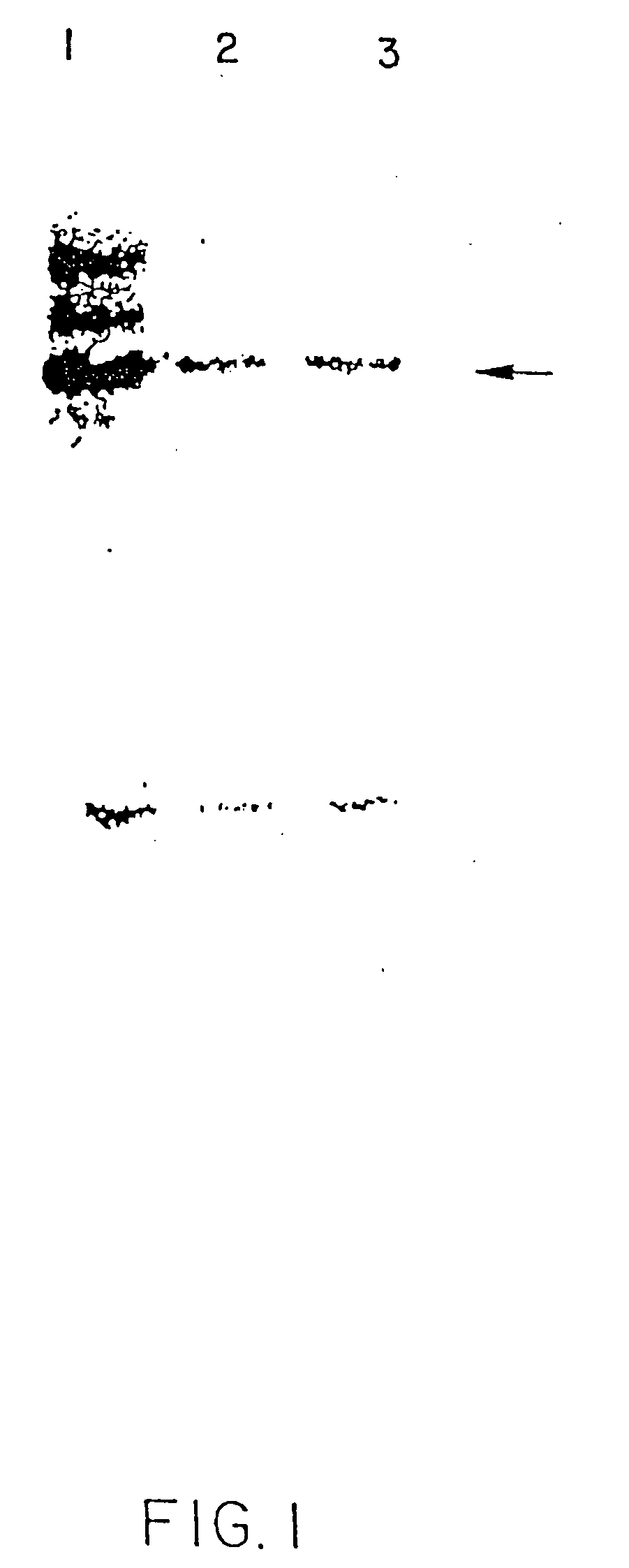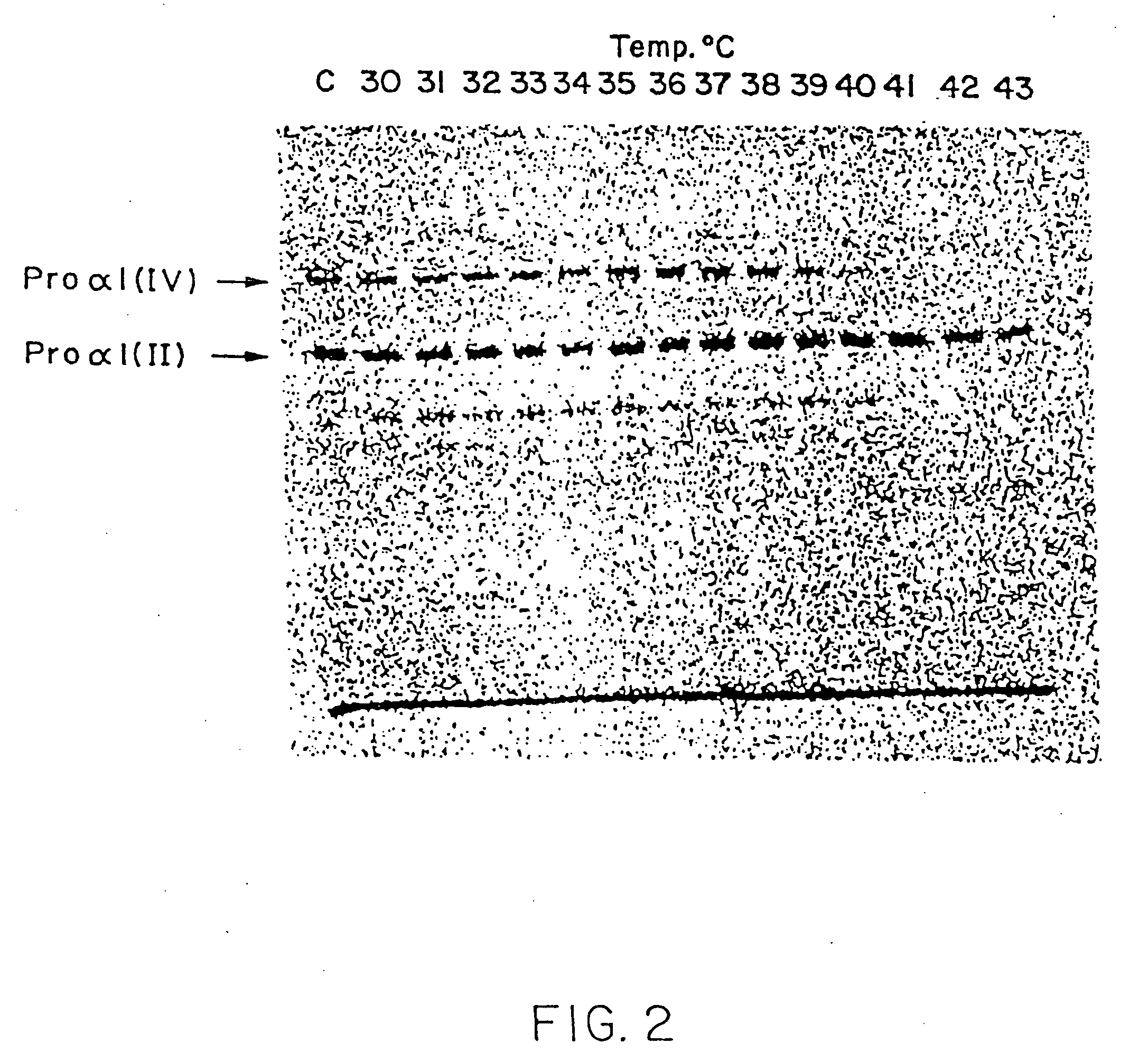Synthesis of human procollagens and collagens in recombinant DNA systems
a technology of human procollagen and synthesis, which is applied in the direction of connective tissue peptides, animal/human proteins, enzymes, etc., can solve the problems of poor cell secretion, inability to self-assemble into collagen fibrils, and difficult to obtain expression,
- Summary
- Abstract
- Description
- Claims
- Application Information
AI Technical Summary
Benefits of technology
Problems solved by technology
Method used
Image
Examples
example 1
Synthesis of Human Type II Procollagen
[0124] A recombinant COL1A1 gene construct employed in the present invention comprised a fragment of the 5′-end of COL1A1 having a promotor, exon 1 and intron 1 fused to exons 3 through 54 of a COL2A1 gene. The hybrid construct was transfected into HT-1080 cells. These cells were co-transfected with a neomycin-resistance gene and grown in the presence of the neomycin analog G418. The hybrid construct was used to generate transfected cells.
[0125] A series of clones were obtained that synthesized mRNA for human type II procollagen. To analyze the synthesized proteins, the cells were incubated with [14C] proline so that the medium proteins could be analyzed by autoradiography (storage phosphor film analyzer).
[0126] As set forth at FIG. 1, lane 1 shows that the unpurified medium proteins are comprised of three major polypeptide chains. Specifically, the medium proteins contained the expected type II procollagen comprised of proα1(II) chains toget...
example 2
Synthesis of Human Type I Procollagen
[0128] As a second example, HT-1080 cells were co-transfected with a COL1A1 gene and a COL1A2 gene. Both genes consisted of a cytomegalic virus promoter linked to a full-length cDNA. The COL1A2 gene construct but not the COL1A1 gene construct contained a neomycin-resistance gene. The cells were selected for expression of the COL1A2-neomycin resistance gene construct by growth in the presence of the neomycin-analog G418. The medium was then examined for expression of the COL1A1 with a specific polyclonal antibody for human proα1(1) chains.
[0129] More specifically, the COL1A2 was linked to an active neomycin-resistance gene but the COL1A1 was not. The cells were screened for expression of the COL1A2-neomycin resistance gene construct with the neomycin analog G418. The medium was analyzed for expression of the COL1A1 by Western blotting with a polyclonal antibody specific for the human proα1(I) chain. As set forth in FIG. 3, lane 1 indicates that ...
example 3
Cell Transfections
[0132] For cell transfection experiments, a cosmid plasmid clone containing the gene construct was cleaved with a restriction endonuclease to release the construct from the vector. A plasmid vector comprising a neomycin resistance gene, (Law et al., Mol. Cell. Biol. 3: 2110-2115 (1983)) was linearized by cleavage with BamHI. The two samples were mixed in a ratio of approximately 10: 1 gene construct to neomycin resistant gene, and the mixture was then used for cotransfection of HT-1080 cells by calcium phosphate coprecipitation (Sambrook et al., Molecular Cloning. A Laboratory Manual, Cold Spring Harbor Laboratory Press, 2d Edition (1989)). DNA in the calcium phosphate solution was layered onto cultured cells without 10 μg of chimeric gene construct per 100 ml plate of preconfluent cells. Cells were incubated in DMEM containing 10% newborn calf serum for 10 hours. The samples were subjected to glycerol shock by adding a 15% glycerol solution for 3 minutes. The cel...
PUM
 Login to View More
Login to View More Abstract
Description
Claims
Application Information
 Login to View More
Login to View More - R&D
- Intellectual Property
- Life Sciences
- Materials
- Tech Scout
- Unparalleled Data Quality
- Higher Quality Content
- 60% Fewer Hallucinations
Browse by: Latest US Patents, China's latest patents, Technical Efficacy Thesaurus, Application Domain, Technology Topic, Popular Technical Reports.
© 2025 PatSnap. All rights reserved.Legal|Privacy policy|Modern Slavery Act Transparency Statement|Sitemap|About US| Contact US: help@patsnap.com



